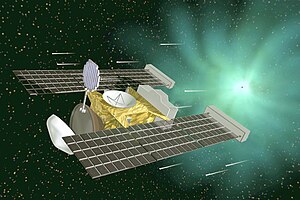
Back ستارداست (مسبار فضائي) Arabic Стардъст Bulgarian Stardust Catalan Stardust (sonda) Czech Stardust (Raumsonde) German Stardust (sonda espacial) Spanish Stardust Estonian Stardust (espazio zunda) Basque فضاپیمای استارداست Persian Stardust (luotain) Finnish
 Artist's impression of Stardust at Comet Wild 2 | |||||||||||||
| Names | Discovery 4 Stardust-NExT | ||||||||||||
|---|---|---|---|---|---|---|---|---|---|---|---|---|---|
| Mission type | Sample return | ||||||||||||
| Operator | NASA / JPL | ||||||||||||
| COSPAR ID | 1999-003A | ||||||||||||
| SATCAT no. | 25618 | ||||||||||||
| Website | stardust stardustnext | ||||||||||||
| Mission duration | Stardust: 6 years, 11 months, 7 days NExT: 4 years, 2 months, 7 days Total: 9 years, 1 month, 17 days | ||||||||||||
| Spacecraft properties | |||||||||||||
| Bus | SpaceProbe[1] | ||||||||||||
| Manufacturer | Lockheed Martin University of Washington | ||||||||||||
| Launch mass | 385 kg[2] | ||||||||||||
| Dry mass | 305.397 kg (673 lb)[3] | ||||||||||||
| Dimensions | Bus: 1.71 × 0.66 × 0.66 m[1] (5.6 × 2.16 × 2.16 ft) | ||||||||||||
| Power | 330 W (Solar array / NiH2 batteries) | ||||||||||||
| Start of mission | |||||||||||||
| Launch date | 7 February 1999, 21:04:15.238 UTC[4] | ||||||||||||
| Rocket | Delta II 7426-9.5 #266 | ||||||||||||
| Launch site | Cape Canaveral SLC-17 | ||||||||||||
| Contractor | Lockheed Martin Space Systems | ||||||||||||
| End of mission | |||||||||||||
| Disposal | Decommissioned | ||||||||||||
| Deactivated | Spacecraft: 24 March 2011, 23:33 UTC[5] | ||||||||||||
| Landing date | Capsule: 15 January 2006, 10:12 UTC[6] | ||||||||||||
| Landing site | Utah Test and Training Range 40°21.9′N 113°31.3′W / 40.3650°N 113.5217°W | ||||||||||||
| Flyby of Earth | |||||||||||||
| Closest approach | 15 January 2001, 11:14:28 UTC | ||||||||||||
| Distance | 6,008 km (3,733 mi) | ||||||||||||
| Flyby of asteroid 5535 Annefrank | |||||||||||||
| Closest approach | 2 November 2002, 04:50:20 UTC[7] | ||||||||||||
| Distance | 3,079 km (1,913 mi)[7] | ||||||||||||
| Flyby of periodic comet Wild 2 | |||||||||||||
| Closest approach | 2 January 2004, 19:21:28 UTC[7] | ||||||||||||
| Distance | 237 km (147 mi)[7] | ||||||||||||
| Flyby of Earth (Sample return) | |||||||||||||
| Closest approach | 15 January 2006 | ||||||||||||
| Flyby of Earth | |||||||||||||
| Closest approach | 14 January 2009, 12:33 UTC | ||||||||||||
| Distance | 9,157 km (5,690 mi) | ||||||||||||
| Flyby of Comet Tempel 1 | |||||||||||||
| Closest approach | 15 February 2011, 04:39:10 UTC[8] | ||||||||||||
| Distance | 181 km (112 mi)[9] | ||||||||||||
| |||||||||||||
 
| |||||||||||||
Stardust was a 385-kilogram robotic space probe launched by NASA on 7 February 1999. Its primary mission was to collect dust samples from the coma of comet Wild 2, as well as samples of cosmic dust, and return them to Earth for analysis. It was the first sample return mission of its kind. En route to Comet Wild 2, it also flew by and studied the asteroid 5535 Annefrank. The primary mission was successfully completed on 15 January 2006 when the sample return capsule returned to Earth.[10]
A mission extension, codenamed NExT, culminated in February 2011 with Stardust intercepting Comet Tempel 1, a small Solar System body previously visited by Deep Impact in 2005. Stardust ceased operations in March 2011.
On 14 August 2014, scientists announced the identification of possible interstellar dust particles from the Stardust capsule returned to Earth in 2006.[11][12][13][14]
- ^ a b "Stardust Launch" (PDF) (Press Kit). NASA. February 1999. Archived (PDF) from the original on 16 November 2001.
- ^ "Stardust". NASA's Solar System Exploration website. Retrieved 2 December 2022.
- ^ "Instrument Host Information: Stardust". Planetary Data System. NASA. Retrieved 20 January 2018.
- ^ "Stardust/NExT". NASA Space Science Data Coordinated Archive. Retrieved 20 January 2018.
- ^ Agle, D. C.; Brown, Dwayne (25 March 2011). "NASA Stardust Spacecraft Officially Ends Operations". NASA. Archived from the original on 10 April 2016. Retrieved 16 January 2016.
- ^ Muir, Hazel (15 January 2006). "Pinch of comet dust lands safely on Earth". New Scientist. Retrieved 20 January 2018.
- ^ a b c d "Mission Information: Stardust". Planetary Data System. Retrieved 20 January 2018.
- ^ "Mission Information: Next". Planetary Data System. Retrieved 20 January 2018.
- ^ Greicius, Tony, ed. (14 February 2011). "NASA's Stardust Spacecraft Completes Comet Flyby". NASA. Archived from the original on 4 June 2017. Retrieved 20 January 2018.
- ^ Dolmetsch, Chris (15 January 2006). "NASA Spacecraft Returns With Comet Samples After 2.9 Bln Miles". Bloomberg. Archived from the original on 28 March 2014.
- ^ Agle, DC; Brown, Dwayne; Jeffs, William (14 August 2014). "Stardust Discovers Potential Interstellar Space Particles". NASA. Retrieved 14 August 2014.
- ^ Dunn, Marcia (14 August 2014). "Specks returned from space may be alien visitors". AP News. Retrieved 14 August 2014.
- ^ Hand, Eric (14 August 2014). "Seven grains of interstellar dust reveal their secrets". Science. Retrieved 14 August 2014.
- ^ Westphal, A. J.; Stroud, R. M.; Bechtel, H. A.; Brenker, F. E.; et al. (2014). "Evidence for interstellar origin of seven dust particles collected by the Stardust spacecraft" (PDF). Science. 345 (6198): 786–791. Bibcode:2014Sci...345..786W. doi:10.1126/science.1252496. hdl:2381/32470. PMID 25124433. S2CID 206556225.
© MMXXIII Rich X Search. We shall prevail. All rights reserved. Rich X Search